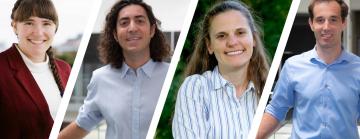DOE honors four SLAC and Stanford scientists with Early Career Awards
Leora Dresselhaus-Marais, Claudio Emma, Bernhard Mistlberger and Johanna Nelson Weker will pursue cutting-edge research into decarbonizing steel production, theoretical physics, generating more intense particle beams, and improving X-ray microscopes.
By Angela Anderson and David Krause
Three scientists from the Department of Energy’s SLAC National Accelerator Laboratory and one Stanford and SLAC professor will receive Early Career Research Program grants for their work on reducing greenhouse gas emissions caused by steel manufacturing, boosting the performance and power of particle beams, measuring particle masses and interactions more accurately, and making clearer X-ray images of battery cells and other samples.
Leora Dresselhaus-Marais, Claudio Emma, Bernhard Mistlberger, and Johanna Nelson Weker were among 93 early career scientists in the U.S. to receive the prestigious five-year funding grants. In total, the DOE issued a combined $135 million for research covering a wide range of topics, from artificial intelligence to astrophysics to fusion energy.
“Supporting America’s scientists and researchers early in their careers will ensure the United States remains at the forefront of scientific discovery,” said U.S. Secretary of Energy Jennifer M. Granholm. “The funding announced today gives the recipients the resources to find the answers to some of the most complex questions as they establish themselves as experts in their fields.”
Leora Dresselhaus-Marais
(Courtesy of Leora Dresselhaus-Marais)
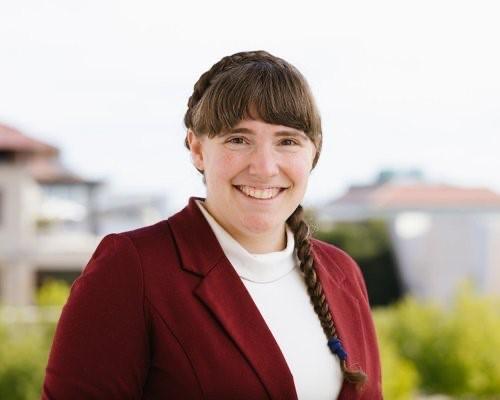
Decarbonizing steel
Leora Dresselhaus-Marais, professor of photon science at SLAC and assistant professor of materials science and engineering at Stanford, came to Stanford and SLAC in 2021. She completed her PhD in physical chemistry at the Massachusetts Institute of Technology in 2018. Prior to SLAC, she did her postdoctoral work as a Lawrence Fellow at Lawrence Livermore National Laboratory, developing novel X-ray imaging techniques.
She’s always been interested in using light to probe and control materials: Physically moving and transforming materials with seemingly intangible forces of light seemed almost like magic, she said. Now, she’s applying her fascination with light to solving science problems that help society, specifically ones related to climate change.
With this award, she’ll use SLAC’s powerful X-ray facilities, the Linac Coherent Light Source and the Stanford Synchrotron Radiation Lightsource (SSRL), to study how nanograins in iron ores behave during the “ironmaking” part of steel manufacturing.
Steel is a critical global commodity, with about 1.94 billion tons of it produced last year. The production of steel accounts for 7-11% of total global greenhouse gas emissions (GHG), and more than half of those emissions come from a single step: converting iron ores into molten iron metal that will get alloyed into steel.
Ironmaking today is done mostly in blast furnaces that use coal and limestone to reduce the iron ores and separate the impurities. A method called hydrogen direct reduction, which uses hydrogen instead of coal to reduce iron ores into iron metal, is the most established zero-carbon version of ironmaking today, but its use has been limited due to challenges scaling the reaction to the appropriate scale, Dresselhaus-Marais said.
The goal of her project, she said, is to improve our understanding of the hydrogen direct reduction chemistry. This will allow her group to find more effective approaches to drive iron-oxygen separations in iron oxide ores, which would help decarbonize the global steel making industry.
“This award will support my team’s work on iron oxide reduction chemistry and how we can control those dynamics in ways that can enable new types of ironmaking technologies,” Dresselhaus-Marais said. “I see this award as a necessary step toward developing disruptive technologies and changing the game on sustainable ironmaking.”
Her mentors at SLAC are excited by Leora’s work because of its interdisciplinary nature.
“Leora discovers and elucidates fundamental science and applies that understanding to address important problems in sustainable manufacturing and materials processing,” said Steve Eglash, director of the Applied Energy Division and deputy chief research officer at SLAC. “This work is quintessential Leora: It will illuminate fundamental mechanisms in the reduction of iron oxide, showing the way to new pathways for steelmaking with reduced greenhouse gas emissions.”
Leora hopes her team’s research on ironmaking will act as a springboard to further investigate sustainable mining, extraction, and separations at SLAC.
Claudio Emma
(Olivier Bonin/SLAC National Accelerator Laboratory)
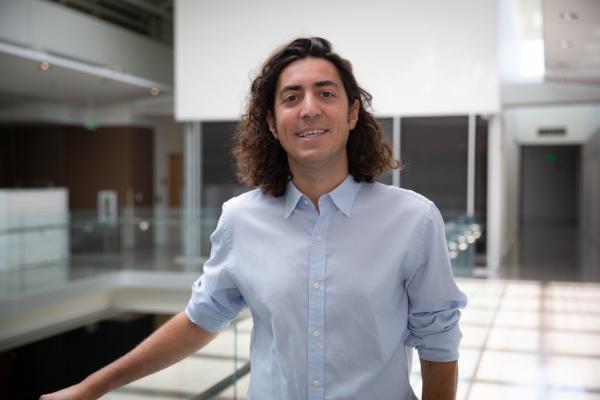
Brighter particle beams
Claudio Emma came to SLAC in 2017 as a research associate after completing a PhD in physics from the University of California, Los Angeles.
Since joining the lab, he has focused on improving the performance of particle beams, which are a fundamental tool for high-energy physics and discovery science. As beams become brighter and more reliable, they help scientists discover more elemental interactions in nature. These interactions range from experiments studying fundamental quantum physics to those exploring ultrafast phenomena with X-rays, such as the intermediate steps that occur in photosynthesis.
“Claudio’s strong background and experience combine advanced accelerator research, beam physics and free-electron lasers,” said Mark Hogan, FACET and Test Facilities Division director at SLAC. “The award will allow Claudio to apply his deep knowledge of artificial intelligence, machine learning and free-electron laser physics to develop novel techniques to characterize particle beams and do proof-of-principle experiments for generating attosecond electron and photon beams. His passion for the work can be seen every day at the lab and inspires his fellow scientists.”
SLAC scientists created the most powerful ultrashort electron beam in the world
Researchers carefully positioned lasers to compress billions of electrons together, creating a beam five times more powerful than ever before.

If everything goes right in Emma’s project, he and his team will demonstrate extreme compression of electron bunches in a particle accelerator – making them, say, 10 to a hundred times shorter than has ever been done before.
“With these shorter bunches, we can unlock the path to future short-bunch and advanced high-energy particle colliders," he said. "In addition, these ultra-short bunches can produce more rapid X-ray pulses to help scientists capture atomic movements.”
Generating more intense beams creates its own problems. For instance, an intense beam can melt the screens that are used to measure its properties – like its energy, size, and momentum.
To avoid melting screens, Emma’s team plans to develop a new diagnostic technique that uses a small undulator, rather than a screen, to measure the beam’s properties without touching it directly as it travels through the accelerator.
To test their concept, they’ll head to SLAC’s advanced accelerator research facility, FACET-II. There, they’ll use the facility’s plasma acceleration technology to help electrons achieve extreme compression by forcing the faster electrons in an electron bunch to travel on a longer path than the slower electrons.
They’ll also look to use weaker magnetic fields while compressing electron bunches. Weaker magnetic fields result in less radiation in the accelerator – an important aspect of the research because radiation can make a beam more chaotic and less reliable, Emma said.
Overall, receiving the award is a “game-changer,” Emma said. It will allow him to take his ideas to the next level, providing the time and resources needed to hopefully generate stronger beams.
“The award is humbling and I feel really lucky to receive it,” he said. “What I really want to do now is turn our ideas into reality so that societal impacts can happen.”
Bernhard Mistlberger
(Olivier Bonin/SLAC National Accelerator Laboratory)
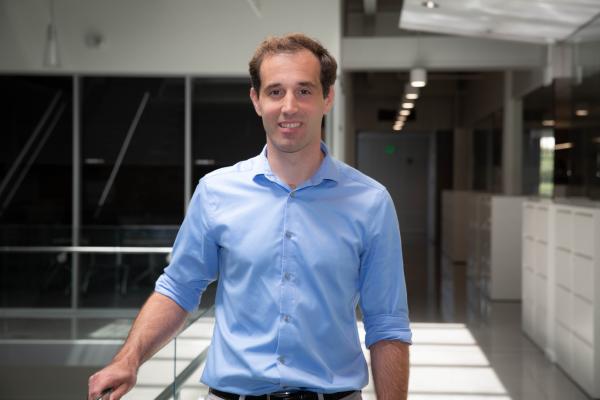
High-precision predictions for particle physics
Growing up in Austria, SLAC theoretical physicist Bernhard Mistlberger was always interested in exploring how the universe works at the most fundamental level. While pursuing his PhD at ETH Zurich, he had the opportunity to do research at the intersection of theory and experiment and found a great place to grow his career.
Today, he makes high-precision theoretical predictions for particle physics experiments at CERN’s Large Hadron Collider (LHC). As experimental particle physicists pursue fundamental questions with ever more precision, theory must keep up, he said.
“We smash together particles at very high energies, then take a look at what’s coming out of the collisions and try to draw conclusions about fundamental interactions – how nature at its smallest distance scales actually works,” Mistlberger explained.
“The LHC is entering a new phase where over the next 10 to 15 years it will produce 20 times the data it has produced so far. That will allow us to measure a lot of things in great detail. And we can only interpret that data if we understand what our experiment should produce.”
In addition, he said, current experiments measure the masses of particles and their interactions to an accuracy of 5% to 10%. He aims to bring that down to plus or minus 1%. The Early Career Award will help him work through some of the obstacles to doing that, including the need for better algorithms to predict the scattering of particles in LHC collisions with ever more precision.
Since Mistlberger came to SLAC in 2020, he has been recognized with multiple awards for his contributions to high-precision quantum field theory – the mathematical framework used to describe particle collisions. The European Physical Society awarded him the Gribov Medal in 2021, and last year he received the American Physical Society’s Henry Primakoff Award for Early-Career Particle Physics.
“Bernhard is a world leader in precision theory for the Large Hadron Collider. His predictions for how often the Higgs boson and other particles are produced at the LHC underpin the study of the Higgs boson by the ATLAS and CMS experiments,” said Lance Dixon, a professor of particle physics and astrophysics at SLAC and Stanford who recently received the Galileo Galilei Medal for his contributions to theoretical physics. “This Early Career Award will allow Bernhard to extend his research to more complex LHC processes.”
The award will help Mistlberger move his work to the next level, he said: “I was very happy to learn about it. It’s a huge recognition of my ideas and my work so far, but it also represents a significant opportunity to enlarge my research group and realize much larger projects.”
Johanna Nelson Weker
(SLAC National Accelerator Laboratory)
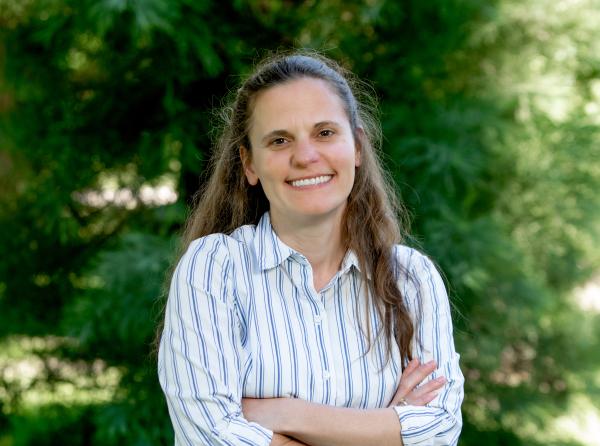
X-rays for better batteries
Johanna Nelson Weker came to SLAC in 2010 after completing her PhD at Stony Brook University. She is now a lead scientist at SSRL.
What drew her to X-ray science is the interdisciplinary nature of the field, she said: “One day, I might be mapping the atomic structure of battery materials, and the next day, I might be studying a paint sample from a Renaissance canvas.”
While she values the ability to think broadly about X-ray science, she has focused primarily on battery research over the years. This wasn’t the case when she came to SLAC – she knew nothing about batteries when she started.
“Batteries turned out to be a really interesting problem that aligned well with the capabilities of the transmission X-ray microscope I’d been working with at SSRL,” she said.
“Johanna has been very creative and entrepreneurial in applying X-ray imaging to probe the operation of battery materials,” SSRL director Paul McIntyre said. “She has shown great instincts for research problem selection, while also effectively supporting key parts of the very active imaging user program at SSRL. Johanna’s enthusiasm for research that impacts important societal issues such as the clean energy transition is infectious. She is an inspiring role model for early career researchers in this field.”
These days at SSRL, she’s trying to discover how to reduce the amount of cobalt in electric vehicle batteries because the element can be difficult to source. She’s also using SSRL’s X-rays to see how disordered rock salts could become a primary material for a battery’s cathode, or positive terminal.
With the early career funding award, she’ll modify an X-ray microscope to take clearer 3D images of wide, non-symmetrical samples like battery pouch cells – a difficult task with today’s X-ray imaging techniques.
Typically, researchers make 3D images of samples by rotating the sample while zapping it with powerful X-rays. A computer compiles the resulting images into a 3D reconstruction of the sample.
“These techniques work really well for samples that are cylinder-shaped, meaning they have a similar thickness no matter how you rotate them,” Nelson Weker said. “But a flat sample, like a battery pouch cell, doesn’t have this shape, so we see various kinds of defects in the images – or we might not get any X-rays completely through the sample at all.”
The updated microscope will allow researchers to rotate wide, non-symmetrical samples at an angle to the incoming X-rays, resulting in clearer 3D images of the thin pouch samples. Doing so will reveal how individual particles and material interfaces inside of batteries behave.
The technique is widely applicable to other important energy systems, such as hydrogen fuel cells, flow batteries, and microelectronic devices, Nelson Weker said.
For questions or comments, contact the SLAC Office of Communications at communications@slac.stanford.edu.
About SLAC
SLAC National Accelerator Laboratory explores how the universe works at the biggest, smallest and fastest scales and invents powerful tools used by researchers around the globe. As world leaders in ultrafast science and bold explorers of the physics of the universe, we forge new ground in understanding our origins and building a healthier and more sustainable future. Our discovery and innovation help develop new materials and chemical processes and open unprecedented views of the cosmos and life’s most delicate machinery. Building on more than 60 years of visionary research, we help shape the future by advancing areas such as quantum technology, scientific computing and the development of next-generation accelerators.
SLAC is operated by Stanford University for the U.S. Department of Energy’s Office of Science. The Office of Science is the single largest supporter of basic research in the physical sciences in the United States and is working to address some of the most pressing challenges of our time.
